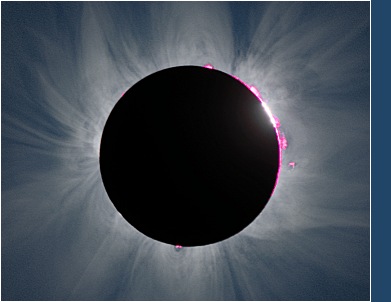 Total solar eclipse is one of the most fascinating astronomical phenomena.
Thousands and sometimes millions of people, as it was in case of the last total eclipse
visible in central Europe, travel to the narrow band of totality to enjoy
fleeting beauty lasting few minutes only. Even people without any knowledge in
physics and astronomy realize during the total eclipse that our Sun is
definitely not a boring light source of a round shape shining down from the heaven but an
extremely interesting living star which occupies surprisingly large part of
the sky.
Total solar eclipse is one of the most fascinating astronomical phenomena.
Thousands and sometimes millions of people, as it was in case of the last total eclipse
visible in central Europe, travel to the narrow band of totality to enjoy
fleeting beauty lasting few minutes only. Even people without any knowledge in
physics and astronomy realize during the total eclipse that our Sun is
definitely not a boring light source of a round shape shining down from the heaven but an
extremely interesting living star which occupies surprisingly large part of
the sky.
Astonishing series of scientific discoveries were made during the
rare total solar eclipses. Probably the most famous one was done
on May 29th 1919 when it was proved that the Sun behaves like
a giant achromatic gravitational lens as it was predicted by Einstein's
general relativity theory. Although nowadays cosmic
probes greatly extended the possibilities of observing the Sun as the telescopes
can be placed outside the interfering Earth's atmosphere, each total solar eclipse
remains a scientific event of great importance. Total solar eclipse gives an unique
opportunity to take advantage of digital cameras, advanced photographic films, fast computers, and
modern mathematics and create images of inner corona in the
quality which
is nowadays impossible to be reached by any other way. The main aim of these Web pages
is to prove that the previous sentence is truthful and that from the scientific point
of view it makes sense to organize expeditions to each total solar eclipse.
Other types of eclipses as partial solar eclipses or
lunar eclipses are presented on these Web pages too. I would like
to illustrate wide possibilities of mathematical image
processing or simply to show the beauty of the phenomenon.
Miloslav Druckmüller
Institute of Mathematics, Faculty of Mechanical Engineering
Brno University of Technology, Czech Republic
druckmuller@fme.vutbr.cz
Page last update: 20.9.2017
|